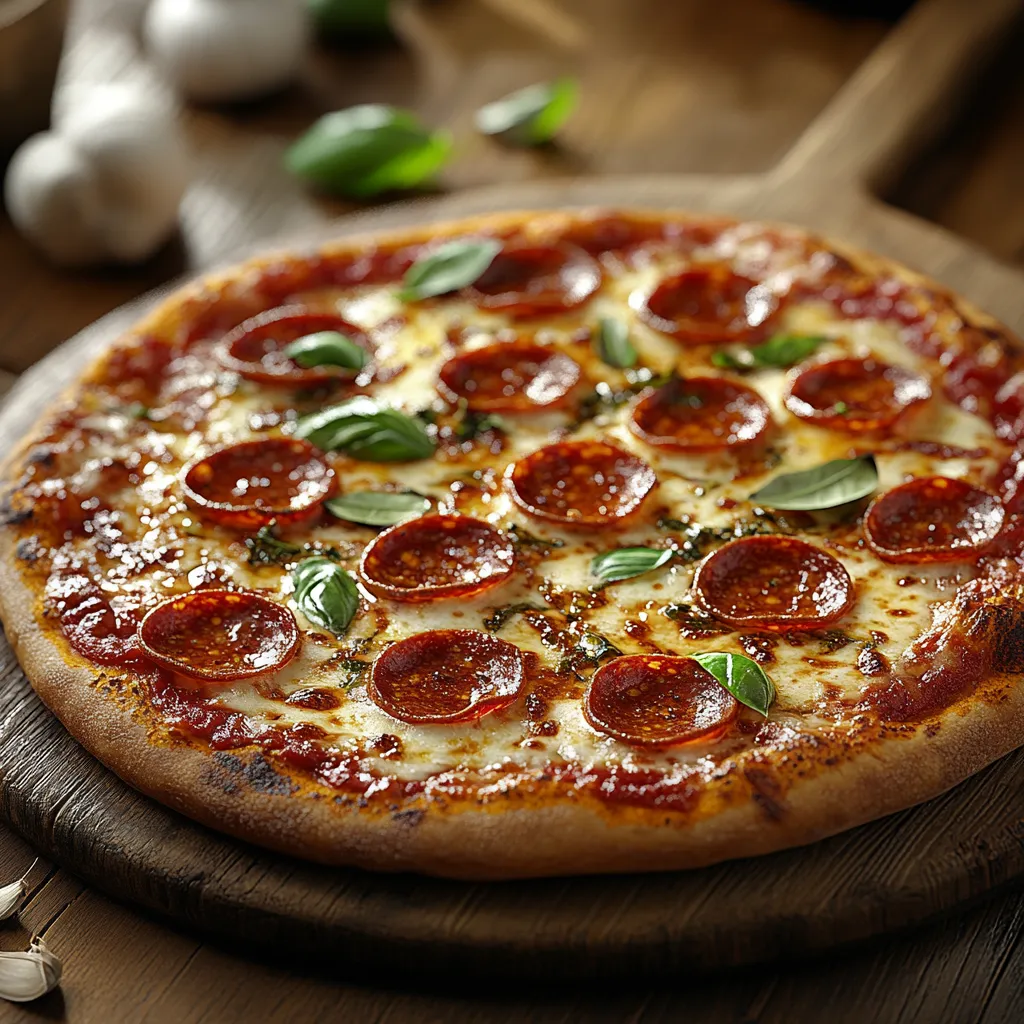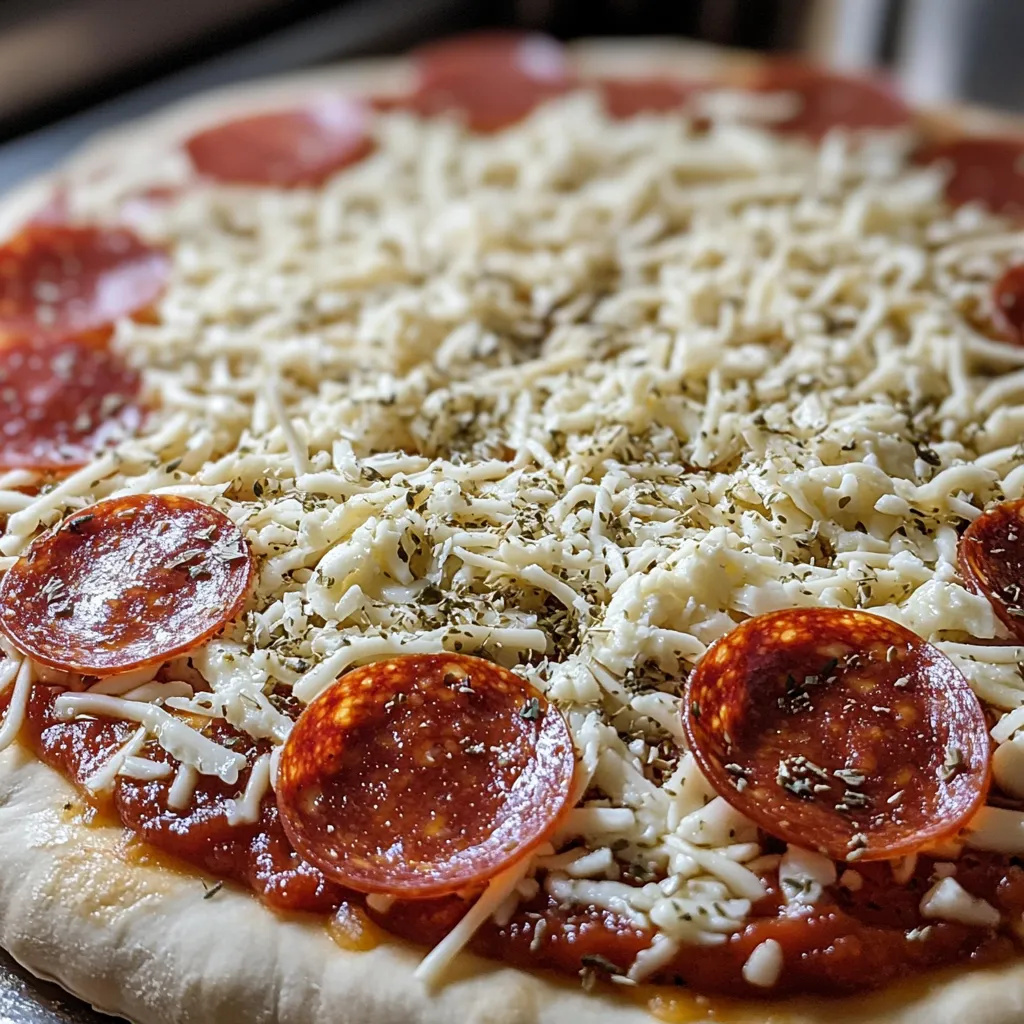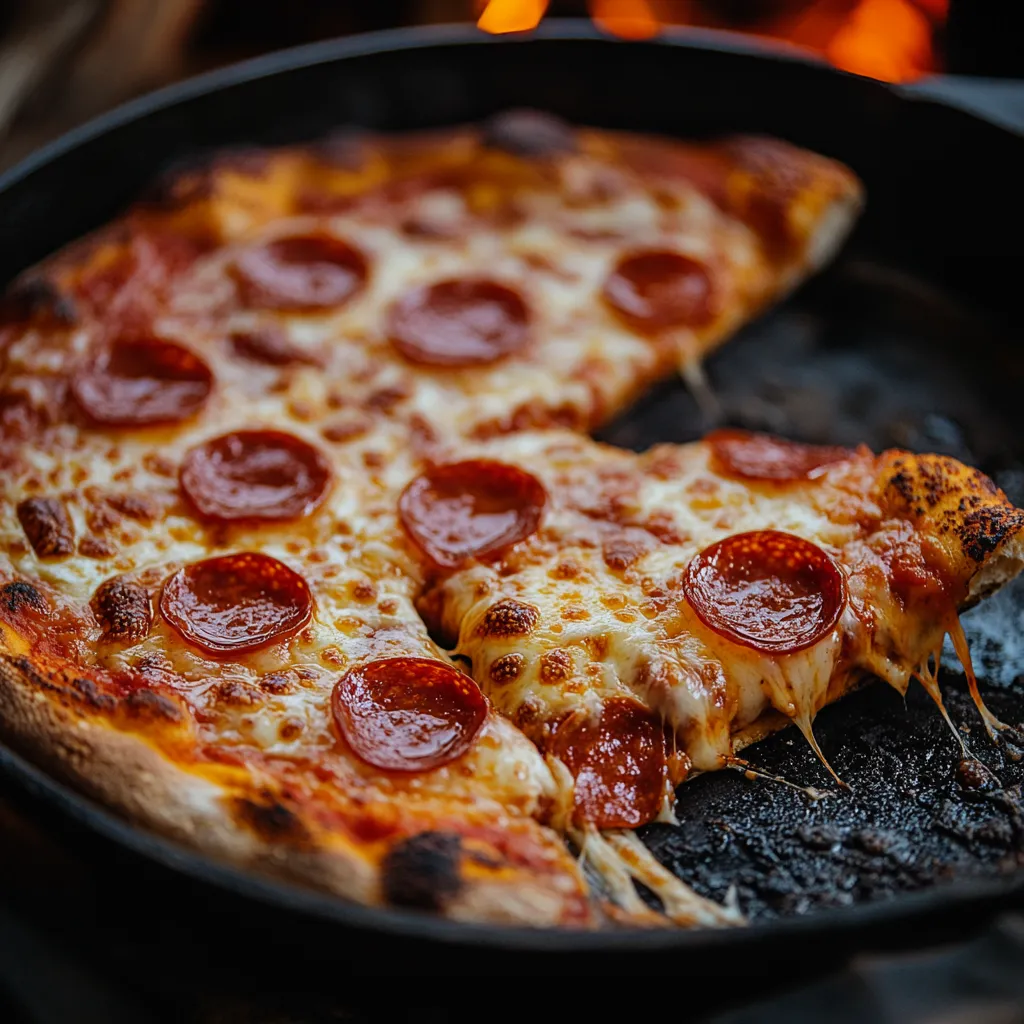The Best Fluffy Pancakes recipe you will fall in love with. Full of tips and tricks to help you make the best pancakes.

There’s just something magical about a slice of homemade pepperoni pizza. It’s cheesy, crispy, flavorful, and—best of all—you made it yourself. Whether you’re cooking for family pizza night or simply craving something better than takeout, this recipe will help you create the perfect pie right in your kitchen.
In this article, you’ll learn everything from choosing the right ingredients, making or buying pizza dough, crafting a tasty sauce, and baking the pizza to golden perfection. We’ll also cover fun variations, reheating tips, and even dipping sauce ideas. Homemade pepperoni pizza isn’t just a recipe—it’s a fun, hands-on experience that’s surprisingly easy and way more rewarding than delivery.
Table of Contents
Part 1: Why Make Pepperoni Pizza at Home?

Making homemade pepperoni pizza isn’t just about saving money—it’s about creating something delicious, fresh, and made exactly how you like it. If you’ve never tried making pizza from scratch, you’re in for a treat.
Save Money and Time
Sure, dialing for delivery is easy, but those costs stack up quickly. Homemade pizza can be made with basic ingredients that are super affordable—and you probably already have most of them in your kitchen. Plus, once you get the hang of it, you’ll whip up a fresh pizza faster than your local delivery guy can get to your door.
You’ll also save time waiting around or dealing with a lukewarm pizza that’s been sitting in a box. Baking at home means you get your pepperoni pizza hot, fresh, and straight from the oven.
Make It Just the Way You Like
One of the best parts of cooking at home? Full control. Whether you love extra cheese, want a crispy crust, or prefer to pile on the spicy pepperoni, it’s all up to you. Want to sneak in veggies for the kids? Go for it. Craving a stuffed crust? You can do that, too.
Not only does homemade pepperoni pizza give you better taste and texture—it gives you the freedom to customize every slice. Now that’s a win-win.
Part 2: Ingredients You Need for Homemade Pepperoni Pizza
Before you roll out the dough or preheat the oven, let’s talk ingredients. One of the best things about making homemade pepperoni pizza is that you don’t need anything fancy. A few fresh, simple items go a long way.
Basic Ingredients for the Crust, Sauce, and Toppings
For the crust, you can either make your own or grab a ball of store-bought pizza dough. Either way works like a charm. For the sauce, go with a quick homemade mix or a quality jarred version. Just make sure it’s not too watery—it could make the crust soggy.
You’ll also need shredded mozzarella cheese, a bit of flour for rolling, and your favorite pepperoni slices. Oh, and don’t forget olive oil and a pinch of herbs like oregano or basil for that extra flavor punch.
Choosing the Best Pepperoni and Cheese
When it comes to pepperoni, thinner slices crisp up better, giving you that perfect charred edge. Want a twist? Try chopped beef pepperoni, like in this beef pepperoni pizza version, for a smoky, meaty flavor.
For cheese, mozzarella is the gold standard. But feel free to add a little provolone or Parmesan to the mix if you’re feeling bold. The blend makes each bite richer and more gooey—exactly what you want in a homemade pizza.
Part 3: Making Pizza Dough at Home

Sure, grabbing dough from the store is easy—but if you’ve got a little time, homemade dough is where the magic begins. Making the crust yourself lets you control the texture, taste, and thickness.
Simple No-Knead Dough Recipe
Don’t worry, you don’t need to be a baking pro. A no-knead pizza dough is a breeze to whip up and only takes a few ingredients: flour, yeast, water, olive oil, and salt. Just mix them together, let the dough rest for a few hours (or overnight), and you’re good to go. The long rest helps the dough develop flavor without much effort on your part.
Once it’s ready, dust your counter with flour and roll the dough into a 12 to 14-inch circle. Letting the dough sit at room temperature for 10–15 minutes before rolling helps make it more flexible and easy to shape.
Tips for Store-Bought Dough
Pressed for time? No shame in going the store-bought route. Many local grocery stores carry fresh pizza dough in the bakery or freezer section. Some pizzerias even sell dough balls—just ask!
To make store-bought dough behave, let it come to room temperature before rolling. Cold dough is stiff and more likely to tear. With a little olive oil and some gentle stretching, even pre-made dough can deliver that crispy, chewy crust we all love in homemade pepperoni pizza.
Part 4: The Perfect Sauce for Your Homemade Pepperoni Pizzas
If the crust is the base of your homemade pepperoni pizza, the sauce is definitely the soul. It ties everything together with its zesty, tangy flavor—and luckily, making it at home is a breeze.
Quick Homemade Pizza Sauce Recipe
For a bold, flavorful sauce, all you need are a few pantry staples: tomato sauce (or crushed tomatoes), a pinch of salt, garlic powder, onion powder, a splash of olive oil, and a dash of red pepper flakes if you like a little heat. Stir everything together in a bowl—no cooking needed!
Want to deepen the flavor? Let it sit for 10–15 minutes before spreading it on your dough. The spices will blend beautifully, giving your pizza that classic pizzeria taste without the added sugar or preservatives found in many store-bought sauces.
Best Jarred Sauces if You’re in a Rush
Not in the mood to DIY? That’s totally fine. Plenty of great jarred pizza sauces can save time without sacrificing flavor. Look for low-sugar versions with real tomatoes and herbs. Brands with thicker consistency work better—they won’t make your crust soggy.
Whichever route you choose, don’t overdo the sauce. A light, even layer lets the crust stay crisp and helps your homemade pepperoni pizza bake evenly.
Part 5: Building Your Homemade Pepperoni Pizza

Now comes the fun part—assembling your pizza! Once your dough is ready and your sauce is prepped, it’s time to bring all the pieces together.
Rolling Out the Dough the Right Way
Start by sprinkling some flour on your countertop to prevent sticking. Gently press your dough into a flat circle, working from the center outwards. Use your hands or a rolling pin, whichever you’re more comfortable with. Don’t worry if it’s not perfectly round—rustic shapes add charm.
If the dough keeps springing back, let it rest for five minutes to relax the gluten. Then stretch it again. For most home ovens, a 12 to 14-inch diameter works best.
Next, transfer the rolled-out dough to a pizza stone, baking sheet, or cast iron skillet—whichever method you’re using to cook.
Layering Sauce, Cheese, and Pepperoni (Bonus Pepperoni Tip!)
Start with a thin, even layer of sauce, leaving a small border around the edges. Then sprinkle shredded mozzarella generously over the top.
Here’s a fun twist for better flavor: chop up half of your pepperoni and scatter it under the cheese. Then place the rest of the slices on top. This “bonus pepperoni” trick melts flavor into every bite and keeps the top layer from getting greasy.
Finally, finish with a sprinkle of black pepper and herbs like oregano or basil if you like. Boom—you’ve built a homemade pepperoni pizza that’s flavorful, layered, and ready for the oven.
🍕 For more delicious recipes, check out our other easy and flavorful ideas over at Your Recipes.
Part 6: Best Ways to Cook Homemade Pepperoni Pizza
You’ve made the dough, prepped the toppings, and built your pie—now it’s time to bake! The way you cook your homemade pepperoni pizza can make or break your crust, so let’s talk about two great home-kitchen methods.
Using a Pizza Stone for a Crispy Crust
If you’re chasing that classic crispy bottom and bubbly top, a pizza stone is your best friend. Place the stone in the oven and preheat it at 500°F (or higher if your oven allows) for at least 20 minutes. This gives it time to absorb heat and deliver that professional-style crunch.
Once the stone is hot, slide your pizza onto it using a pizza peel or parchment paper. Bake for 12–14 minutes, rotating halfway through for even cooking. The result? A crust that’s golden and firm enough to hold all that cheesy goodness.
Cooking in a Cast Iron Skillet for a Thick Crust
Don’t have a pizza stone? No worries—a cast iron skillet works wonders. Press the dough into a lightly oiled skillet, then cook it on the stovetop for two minutes before transferring it to the oven.
Bake at 500°F for about 10–12 minutes. This method gives you a thicker, chewier crust with crispy edges and a soft center. It’s perfect if you like a little more bite to your base.
Either way, both methods will give your homemade pepperoni pizza a deliciously baked finish—just the way pizza should be.
Part 7: Tips for a Crispy Crust and Melty Cheese
A soggy crust and rubbery cheese? No thanks. Luckily, with just a few tricks, you can avoid these common pizza pitfalls and make your homemade pepperoni pizza pop.
Oven Temperature and Preheating Tips
One of the biggest secrets to pizza success is heat. A hot oven helps your dough rise fast and cook evenly. Aim for 500°F or more if your oven can handle it. And don’t forget to preheat for at least 20–30 minutes—especially if you’re using a pizza stone.
Also, let your dough come to room temp before rolling. Cold dough resists shaping and won’t bake as evenly.
Common Mistakes to Avoid
Here are a few no-nos to keep in mind:
- Too much sauce can make the center soggy. Use just enough to coat the dough.
- Overloading with cheese or toppings can cause uneven cooking.
- Not rotating the pizza halfway through can lead to burnt edges on one side.
Want ultra-melty cheese? Shred it fresh instead of using pre-shredded (which often contains anti-caking agents). It melts smoother and browns beautifully.
With these small but mighty tips, you’ll take your homemade pepperoni pizza from good to oh-my-goodness good in no time.
Part 8: Fun Toppings and Variations
While a classic homemade pepperoni pizza is always a winner, sometimes it’s fun to switch things up. Playing with toppings lets you get creative and tailor your pie to everyone’s taste buds.
Extra Cheese, Veggies, and Meats
Sure, pepperoni and mozzarella are the stars—but they don’t mind sharing the spotlight. Add a sprinkle of sharp Parmesan or creamy provolone for an extra cheesy bite. Want something fresh? Toss on thinly sliced bell peppers, mushrooms, or red onions. These roast beautifully in the oven and add great flavor and texture.
Looking for more protein? Try adding cooked sausage, spicy salami, or even crumbled bacon. Just make sure not to overload your pizza, or the crust won’t cook evenly.
Kid-Friendly and Custom Pizza Ideas
Making pizza at home is a fun way to get kids involved in the kitchen. Let them build their own mini pizzas using toppings they love—maybe even pineapple (we won’t judge!).
For a twist, you can even turn this homemade pepperoni pizza into a calzone by folding it over before baking. Or try a stuffed crust by tucking cheese around the edges before sealing.
There’s no right or wrong when it comes to pizza toppings—so go ahead and make it your own.
Part 9: How to Store and Reheat Leftover Pizza

So, you’ve made the perfect homemade pepperoni pizza—but what if you’ve got leftovers? Don’t worry, they’re just as good the next day (or the next… if they last that long!).
Storing Pizza in the Fridge
First things first: let the pizza cool completely before storing. Place slices in an airtight container or wrap them tightly in foil or plastic wrap. You can store them in the fridge for up to three days. Stack slices with parchment paper in between to keep them from sticking.
Best Way to Reheat Without a Microwave
Microwaving pizza might be fast, but it turns that crispy crust into mush. Instead, reheat your pizza in a skillet over medium heat. Cover it with a lid and let it warm up for about 3–5 minutes. The bottom stays crisp, and the cheese melts like new.
That way, your leftover homemade pepperoni pizza tastes almost as fresh as when it came out of the oven.
Part 11: Frequently Asked Questions (FAQ)
Got questions? You’re not alone! Here are some quick answers about making homemade pepperoni pizza.
How do I make homemade pizza taste like restaurant pizza?
Crank your oven as hot as it can safely go (usually 500–550°F), preheat a pizza stone or use a cast iron skillet, and don’t overload the toppings. A hot oven gives that crispy crust and bubbly cheese.
What is the best cheese for pepperoni pizza?
Mozzarella is the go-to. For added richness, mix in provolone, fontina, or Parmesan. Shred your cheese fresh if possible—it melts better and gives that golden brown top we all love.
Can I freeze homemade pizza?
Yes! You can freeze it either before baking (just wrap tightly and freeze unbaked) or after (store slices in a freezer-safe bag). To reheat, use the oven—not the microwave—for best texture.
Why does my pizza crust turn out soggy?
Too much sauce or toppings can weigh it down. Also, make sure your oven is hot enough and that you’re not using wet ingredients. A preheated stone or pan helps keep the crust crispy.





